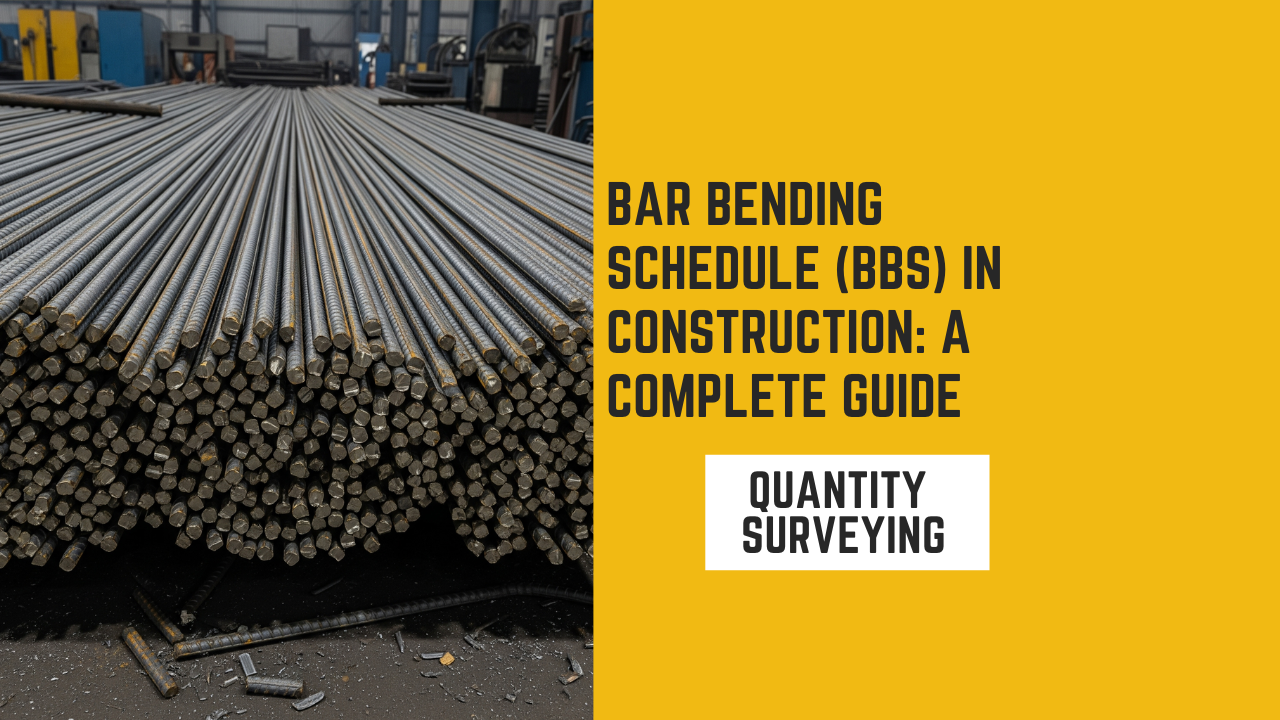Bar Bending Schedule (BBS) in construction: A Complete Guide 2025

Introduction
In the world of civil engineering and construction, precision and organization are crucial. One of the most vital documents in reinforced concrete construction is the Bar Bending Schedule (BBS). It serves as a detailed guide for cutting, bending, and placing steel reinforcement in concrete structures. This article explores the concept, importance, preparation steps and best practices to BBS
What is the bar bending schedule (BBS)?
A bar bending schedule (BBS) is a comprehensive list of steel reinforcement bars required for a concrete structure. It details their dimensions, bending shapes, lengths, and quantities. Essentially, a BBS translates structural drawings into a practical format that can be used directly by the construction team.
It ensures accurate fabrication and correct placement of reinforcement, reduces wastage, and improves construction efficiency. BBS is commonly used for beams, columns, slabs, and foundations.
Importance of Bar Bending Schedule
The bar bending schedule plays a crucial role in construction projects. Key Roles include
1. Accuracy and Precision
BBS ensures the exact quantity and size of steel are used, reducing wastage and avoiding structural weaknesses.
2. Time saving
Workers can cut and bend steel reinforcement without repeatedly referring to structural drawings, saving significant time
3. Cost Efficiency
Accurate bar calculation prevents over-ordering or under-ordering of steel, which is one of the most important construction materials.
4. Simplified Site Management
BBS provides clear instructions for on-site fabrication, making supervision easier and reducing errors.
5. Compliance with Codes and Standards
Proper BBS ensures reinforcement complies with design codes such as IS 456:2000 or BS 8666.
Components of a Bar Bending Schedule
A standard BBS typically contains the following columns:
- Bar Mark or Reference Number—Each steel bar or group is assigned a unique reference for identification.
- Bar Diameter—Diameter of the steel bars in millimeters (e.g., 10 mm, 12 mm, 16 mm).
- Bar Shape Code—Denotes the bending shape (L-shape, U-shape, hooks, bends).
- Cut Length—Total length of the bar before bending, including bends and hooks.
- Number of Bars—Quantity required for each type.
- Total Length—Cut length multiplied by the number of bars.
- Weight of Steel – Calculated using the formula:
Weight of Steel =(D^2 × L)/162
Where:
D = Diameter of bar in mm
L = Total length of bar in metres
This allows engineers to estimate steel requirements accurately and plan procurement efficiently.
Steps to Prepare a Bar Bending Schedule
Creating an accurate BBS requires careful calculation and planning. Follow these steps:
Step 1: Review Structural Drawings
Analyze all reinforced concrete elements such as beams, columns, slabs, and foundations. Note the size, spacing, and reinforcement details in the drawings.
Step 2: Determine Bar Shapes and Sizes
Assign bar marks based on their location and shape. Identify diameter and bending shape. Standard shapes include:
- Straight bars for slabs and columns
- L-shaped bars for cantilever beams
- U-shaped bars for stirrups or ties
- Hooks and bends for anchorage in beams
Step 3: Calculate Cut Length
Cut length is the total steel length before bending. It includes straight lengths plus allowances for hooks and bends.
Step 4: Determine Number of Bars
Count how many bars are required for each type based on the structural plan.
Calculate Total Length and Weight
Multiply the cut length by the number of bars to get the total length. Calculate the weight using the standard formula.
Step 6: Prepare the Schedule Table
Arrange all details in a tabular format, which becomes the working document for the site team.
Example
Calculate bar Bending Schedule of these bars
A. Bar T10 for cutting length 10m
B. Bar T12 for cutting length 10m
Answers
Step 1: Recall the steel weight formula
Weight of Steel =(D^2 × L)/162
Where:
D = Diameter of bar in mm
L = Total length of bar in metres
Step 2: Bar A – 10mm diameter, 10m length
Weight of Steel =(D^2 × L)/162
10^2=100
100×10=1000
1000/162=6.17 kg
Weight per 10m bar (10mm) = 6.17 kg
Step 2: Bar A – 12mm diameter, 10m length
Weight of Steel = (D^2 × L)/162
12^2=144
144×10=1440
1440/162=8.89 kg
Weight per 10m bar (10mm) = 8.89kg
Best Practices for BBS Preparation
- Cross-check drawings—verify all measurements and bar details before preparing the BBS
- Include wastage—add 2-3% extra length for cutting and bending wastage.
- Standardize Bar Shapes—using standard codes reduces confusion on-site.
- Use software tools—AutoCAD, Revit, and Excel can automate calculations and reduce errors.
- Clear Communication—Ensure workers understand all abbreviations, symbols, and measurements
Common Mistakes in BBS Preparation
Even experienced engineers may make errors. Typical mistakes include
- Miscalculating cut lengths for hooks and bends.
- Ignoring bar spacing, leading to insufficient reinforcement
- Forgetting wastage allowances, causing steel shortages
- Incorrect weight calculations, affecting cost estimation
- Avoiding these mistakes ensures safety, efficiency and cost control in the project
Software tools for BBS
- Several software solutions help prepare accurate BBS
- AutoCAD—structural drawings linked with BBS tables
- Revit—BIM Integration allows automatic generation from 3D models
- MS Excel—Widely used for calculations and tabular representation
- Tesla structures—advanced detailing for complex reinforcement
- Using these tools enhances accuracy, reduces manual work, and saves time in large projects.
Advantages of Using BBS in Construction
- Reduced material waste—precise steel estimation lowers waste.
- Time Efficiency—fabrication and placement are streamlined
- Cost Savings—Correct ordering prevents excess expenses
- Enhanced Structural Safety—proper reinforcement placement improves durability
- Simplified Supervision—The site manager can easily verify installation
Conclusion
A Bar Bending Schedule (BBS) is a critical document for reinforced concrete construction. It provides a systematic approach to steel reinforcement detailing, improving accuracy, efficiency, and cost-effectiveness. Preparing BBS carefully and using modern software tools ensures smooth project execution, compliance with standards, and long-lasting structural safety.
Understanding BBS is essential for civil engineers, site supervisors, and students aiming to excel in reinforced concrete construction and project management.






